Exercises (79)
Introduction to HiBa in the field: playful form (burning ball)
Obstacle course in the terrain
A player from team A throws a tennis ball (or if available, the ball is propelled into the field with a baseball bat and a hitting device) or a rugby ball (can also be kicked - either from the air or a team mate holds the ball, which is on the ground) into the playing field (e.g. grass pitch) for the start. The ball must cross a certain line / a defined point high (flying). After the throw, the player enters the obstacle course. Tyres are placed between the obstacles, which act as neutral zones to interrupt the run. Any number of runners may stay in the neutral zones. The team receives one point for each completed run (complete obstacle course). The points are entered on the score sheet by the respective runner after the run. The players of team B try to get the ball to the "burning point" (tyre) as quickly as possible. They are not allowed to run with the ball. Each time the ball falls to the ground (either after team A's throw or between team B's passes), the field team must alternately perform 4 push-ups, 4 trunk bends or 4 stretch jumps before the ball can be returned. If the ball is caught directly by the field team after the throw, the team receives a point, which is noted on the score sheet by the sports director. If a runner is between the obstacles (not at a hoop) at the time when the field team "burns" the ball at the designated spot, he must return to the next neutral zone. If team A has no following thrower, as all other runners are on the obstacle course, the last player of the team has to put the ball into play until a team-mate returns (has completed a run). After a certain time, the teams switch roles.
Variant I:
The basic idea remains the same as described above. One team is in the field, one team completes the obstacle course. However, all additional rules (ball must cross the line in the air and strength exercises when the ball touches the ground) are cancelled. The running team has correspondingly less time to pass the obstacles.
Variant II:
The throwing/punching/kicking team decides for itself how many runners start on a throw/kick. In contrast to the first game form, the last runner in the group is also obliged to start running after his throw/kick. If the team is "starved" as a result, a change is made.
Variant III:
If a runner finds himself between the obstacles when the sports director whistles, he must return to the start and line up in the row of throwers/bats/kickers (or drop out completely and perform additional tasks at the edge of the field). Optionally, it can be defined that only one runner is allowed per tyre.
1 flipchart
1 tennis ball/rugby ball
1 baseball bat (optional)
1 batting device (optional)
11 tyres
Off-road obstacle course
Before each use of the HiBa terrain, the elements must be checked for their suitability and the running track must be cleaned/removed of foreign objects. Minimising the risk of injury (e.g. avenging gravel pits on the climbing wall) is the responsibility of the sports manager and has the highest priority
.Introduction to HiBa in the field: tips & tricks
Obstacle course in the terrain
Present the obstacles, including tips on how to pass the obstacles as quickly as possible.
Depending on the size of the group, the participants can overcome the obstacle one by one after the presentation and practise for the first time.
Obstacle course in the terrain
Before each use of the HiBa terrain, the elements must be checked for their suitability and the course must be cleaned/removed of foreign objects. Minimising the risk of injury (e.g. avenging gravel pits on the climbing wall) is the responsibility of the sports manager and has top priority.
Introduction to HiBa in the field: Training
Obstacle course in the terrain
Single start
Next runner starts as soon as the previous runner has passed the third obstacle
All participants complete a few runs without time pressure to familiarise themselves with the obstacle course (minimise the risk of injury). Optionally, participants can complete a timed run to get an initial indication of their time with a view to a possible competition format.
3 stopwatches (optional for stopping the times)
1 flipchart/evaluation sheet (optional for noting the times)
Obstacle course in the terrain
Before each use of the HiBa terrain, the elements must be checked for their suitability and the course must be cleaned/removed of foreign objects. Minimising the risk of injury (e.g. avenging gravel pits on the climbing wall) is the responsibility of the sports manager and has top priority
Introduction to HiBa in the field: Competition training
Obstacle course in the terrain
Single start
Next runner starts as soon as the previous runner has passed the third obstacle
All participants complete at least one run for time and thus receive an initial time indication with regard to a possible competition form.
3 stopwatches
1 flipchart/evaluation sheet (optional for noting times)
Obstacle course in the terrain
Before each use of the HiBa terrain, the elements must be checked for their suitability and the course cleaned/cleared of foreign objects. Minimising the risk of injury (e.g. avenging gravel pits on the climbing wall) is the responsibility of the sports manager and has top priority
Introduction HiBa in the field: Dice game
Obstacle course in the terrain
The participant throws a number, the obstacle/obstacles are then completed according to the result:
- Double beam / crawling net
- Lion's den / ford
- Beam obstacle (triple beam) / balancing beam
- Waaght jump and crawling beam and crawling beams
- Beam stairs (bear step)
- Running lane / climbing wall
After passing the obstacle, the participant ticks off the corresponding number on a poster (flipchart). Each obstacle must be completed twice to finish the exercise. This means that a half cross (/) is noted for each participant's start number on the first pass and the cross can be completed on the second pass (x). The dice may be rolled twice. If, after the second roll, you still do not have a number that has not been rolled before, you still have to complete the obstacle again, even though it may already be ticked off (variant: run around the obstacle course or touch a specific point such as a tree). Who is the first to tick off all the numbers on the flipchart? If necessary, adapt the exercise to the time conditions and finish after the first ranks if necessary.
4 (foam) dice
1 flipchart (prepared in advance with rows number of participants and columns 1-6)
1 F-discs with pegs/post signs with numbers 1-6
Obstacle course in the terrain
Before each use of the HiBa terrain, the elements must be checked for their suitability and the course cleaned/removed of foreign objects. Minimising the risk of injury (e.g. avenging gravel pits on the climbing wall) is the responsibility of the sports manager and has the highest priority
.Introduction to HiBa in the hall: playful form (burning ball)
Obstacle course in the hall
A player from team A throws a tennis ball into the field at the start (or, if available, the ball is propelled into the field with a baseball bat and a batting device). The ball must cross a certain line high (flying). After the throw (hit), the player enters the obstacle course. Tyres are placed between the obstacles, which act as neutral zones to interrupt the run. Any number of runners may stay in the neutral zones. The team receives one point for each completed run (complete obstacle course). The points are entered on the score sheet by the respective runner after the run. The players of team B try to get the ball to the "burning point" as quickly as possible. They are not allowed to run with the ball. Each time the ball falls to the ground (either after team A's throw or between team B's passes), the field team must alternately perform 4 push-ups, 4 trunk bends or 4 stretch jumps before the ball can be returned (touched). If the ball is caught directly by the field team after the throw, the team receives a point, which is noted on the score sheet by the sports director. If a runner is between the obstacles (not at a hoop) at the time when the field team "burns" the ball at the designated spot, he must return to the next neutral zone. If team A has no following thrower, as all other runners are on the obstacle course, the last player of the team has to put the ball into play until a team-mate returns (has completed a run). After a certain time, the teams switch roles.
Variant I:
The basic idea remains the same as described above. One team is in the field, one team completes the obstacle course. However, the tennis ball is replaced with a rugby ball and all additional rules (ball must cross the line in the air and strength exercises when the ball touches the ground) are cancelled. This means that the running team has less time to pass the obstacles. At the start, the rugby ball is thrown or kicked (either from the air or by a team mate holding the ball on the ground). Once again, the aim is to complete as many laps as possible in the time available. A caught ball by the field team still scores a point.
Variant II:
The throwing/kicking team decides for itself how many runners run after a throw/kick. In contrast to the first game form, the last runner in the group is also obliged to start running after his throw/kick. If the team is "starved" as a result, a change is made.
Variant III:
If a runner finds himself between the obstacles when the sports director whistles, he must return to the start and line up in the row of throwers/bats/kickers (or drop out completely and perform additional tasks at the edge of the field). Optionally, it can be defined that only one runner is allowed per tyre.
11 stakes
11 soft mats (small)
1 soft mat (large)
3 vaulting boxes
3 long benches
1 parallel bars
2 horses
1 flipchart
1 whistle
1 tennis ball
1 baseball bat (optional)
1 batting device (optional)
6 hoops
1 rugby ball ► Variation of the exercise
Introduction to HiBa in the hall: tips & tricks
Obstacle course in the hall
Present the obstacles, including tips on how to pass the obstacles as quickly as possible.
Depending on the size of the group, the participants can overcome the obstacle one by one after the presentation and practise for the first time.
11 stakes
10 soft mats (small)
1 soft mat (large)
3 vaulting boxes
3 long benches
1 parallel bars
2 horses
Introduction HiBa in the hall: training
Obstacle course in the hall
Single start
Next runner starts as soon as the previous runner has passed the third obstacle
The obstacle course in the hall is set up in the specified standard size (volleyball court). All participants complete a few runs without time pressure to familiarise themselves with the obstacle course (minimise the risk of injury). As an option, participants can complete a timed run to get an initial indication of their time with a view to a possible competition format.
11 stakes
10 soft mats (small)
1 soft mat (large)
3 vaulting boxes
3 long benches
1 parallel bars
2 horses
3 stopwatches (optional to stop the times)
1 flipchart/evaluation sheet (optional to note the times)
Introduction to HiBa in the hall: competition training
Obstacle course in the hall
Single start
Next runner starts as soon as the previous runner has passed the third obstacle
The obstacle course in the hall is set up in the specified standard size (volleyball court). All participants complete at least one run for time and thus receive an initial time indication with regard to a possible competition form.
11 stakes
10 soft mats (small)
1 soft mat (large)
3 vaulting boxes
3 long benches
1 parallel bars
2 horses
3 stopwatches
1 flipchart/evaluation sheet (optional for recording times)
Introduction HiBa in the hall: dice game
Obstacle course in the hall
The participant throws a number and then completes the obstacle(s) according to the result:
Roll forwards and slalom around colouring sticks
Crawling under and jumping over the Swedish box elements
Balancing over the narrow side of the long bench
Climbing under/over the bar
Jumping over the horses
Crawling under and jumping over the horses
Jumping over the horses
Jumping over the horses
Crawling under and
Jumping over the horses (Swedish boxes)
Crawling under the large soft mat
After passing the obstacle, the participant ticks off the corresponding number on a poster (flipchart). Each obstacle must be completed twice to finish the exercise. This means that a half cross (/) is noted for each participant's start number on the first pass and the cross can be completed on the second pass (x). The dice may be rolled twice. If, after the second throw, you still do not have a number that has not been thrown before, you still have to complete the obstacle again, even though it may already be ticked off (variant: run around the obstacle course or touch a wall). Who is the first to tick off all the numbers on the flipchart? If necessary, adapt the exercise to the time conditions and finish after the first ranks if necessary.
11 stakes
10 soft mats (small)
1 soft mat (large)
3 vaulting boxes
3 long benches
1 parallel bars
2 horses
4 (foam) dice
1 flipchart (prepared in advance with rows number of participants and columns 1-6)
Introduction to rope climbing technique
Climbing
Demonstration of the rope climbing technique by the instructor:
- For the S-wrap technique, grab the rope as high up as possible with your hands (close together), keeping the rope between your thighs. Now wrap the rope around the weak leg. The rope practically runs once around the calf and finally over the foot further down (S-shape). With the other (strong) foot, step on the rope that has been placed on the weak foot and lock it. Support yourself with the tips of your toes to grab the rope again with your hands (one after the other), preferably at the highest point. Now let go of the rope with the foot clamp grip and pull your legs upwards so that your knees and elbows are almost at the same height. You can then lock the rope again with your feet as described above.
- For the J-hook technique, you stand next to the rope at the start. Here too, you then grab the rope as high as possible. Your hands are close together to stabilise your entire body. Now pull your leg up to your chest with the rope running to the left of your body. With your right foot, grab the rope under your left foot and place it on your left foot to secure it. This creates an angle of over 90 degrees in the rope (J-shape). Once the rope is fixed to the foot, reach up again with your hands one at a time and the process starts all over again (you can switch sides).
1 climbing rope
1-2 soft mats (large)
Introduction to climbing technique on the pole
Climbing
Demonstration of the climbing technique on the pole by the sports leader:
- Press the instep of the back leg and the sole of the front leg against the pole.
- Press both soles of the feet against the pole.
1 climbing pole
2-6 soft mats (small)
Obstacle roller
Parkour
Individual work
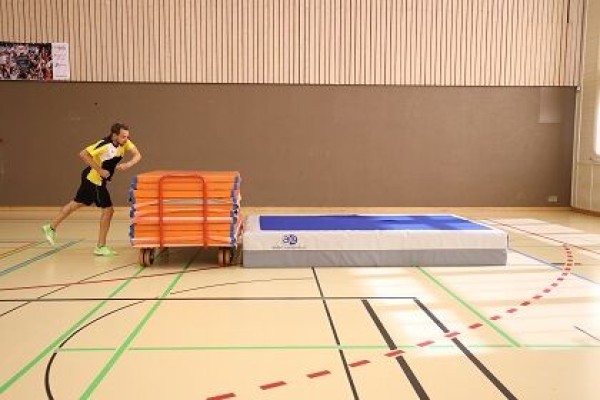

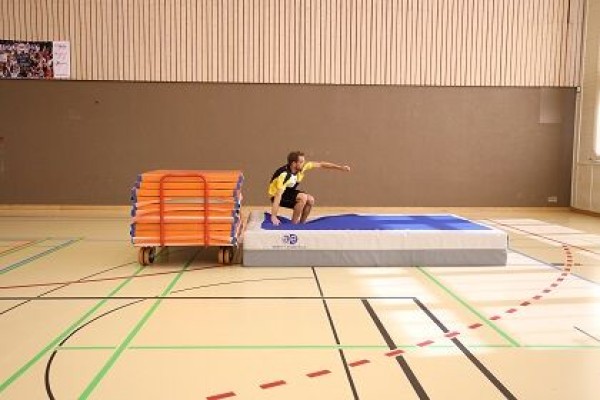
Short run-up, jump in front of the mat trolley, roll over the shoulder girdle, landing on both legs on the large soft mat.
Variant:
Instead of a mat trolley, a vaulting box is used as an obstacle. The height of the mat trolley/swing box can vary.
1 mat trolley incl. soft mats (small)
1 soft mat (large)
Post setup:
Place a small mat trolley (incl. mats) in front of a large soft mat. The mats on the mat trolley are stacked higher than the large soft mat.
Squat jump I
Parkour
Individual work


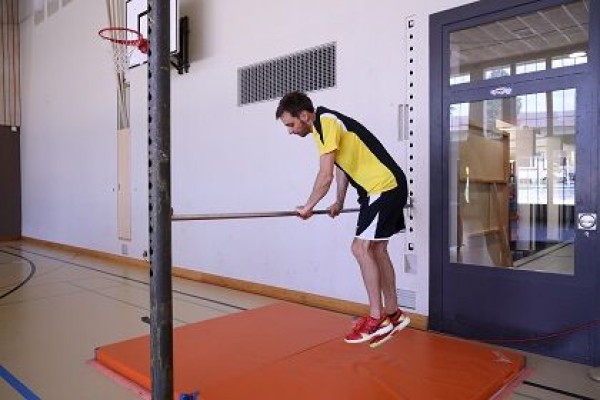
Stand upright, both hands grip the horizontal bar, jump off with both legs for a squat turn over the horizontal bar (180 degree turn).
1 horizontal bar ► indoor version
3 soft mats (small) ► indoor version
Indoor post setup:
Fix a horizontal bar at hip height and place three small soft mats underneath.
outdoor:
1 (horizontal) bar
Hocksprung II
Parkour
Individual work
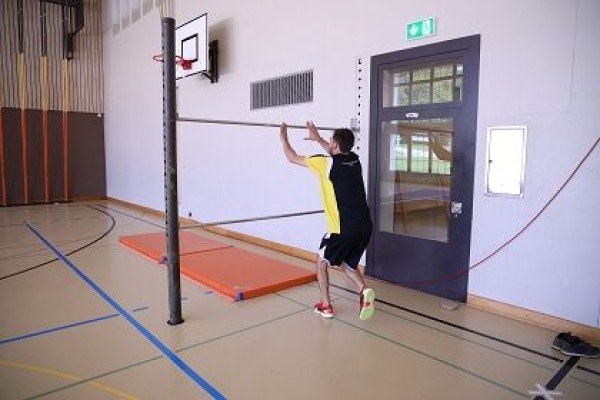
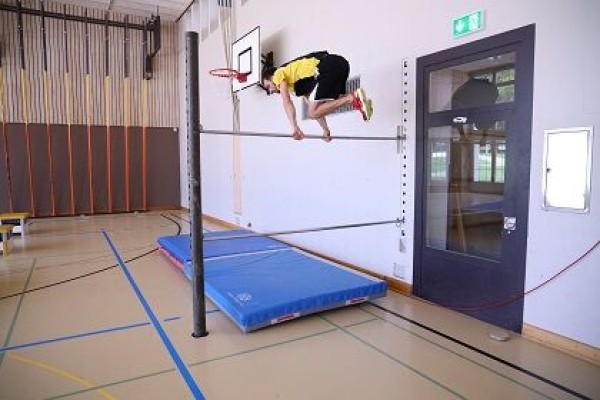

Jump with a running start to the horizontal bars (stand on the lower bar, hold on to the upper bar), jump over the upper horizontal bar, release one hand and squat with your legs slightly diagonally over the bar (squat turn), roll onto the soft mat after landing
.1 horizontal bar
1 additional horizontal bar
3 small soft mats
Post setup:
Hook two horizontal bars approx. one leg length apart, place small soft mats underneath on the floor.
Hocksprung III
Parkour
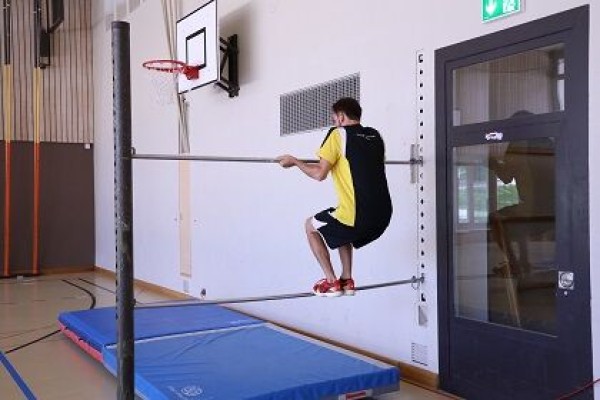
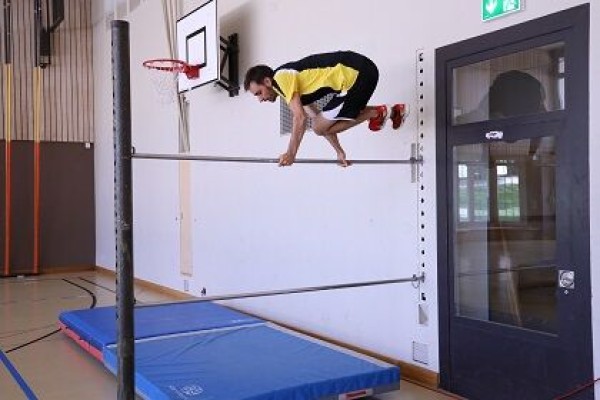
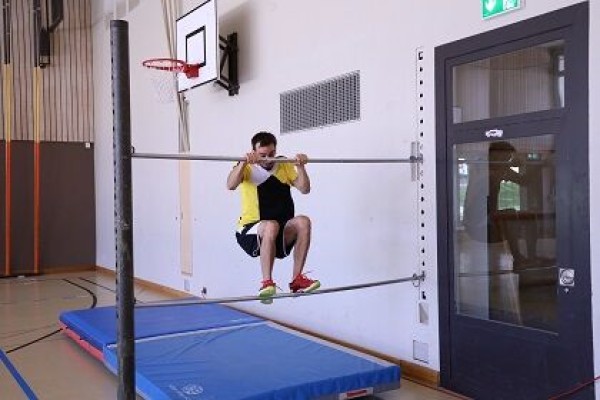
Stand on the lower horizontal bar, hands grasp the upper bar at shoulder width, two-legged jump to the squat turn over the upper horizontal bar, release one hand and grasp it again after the turn, two-legged landing on the lower horizontal bar.
1 horizontal bar
1 additional horizontal bar
3 soft mats (small)
Post setup:
Hook in two horizontal bars with approx. one leg length apart, place small soft mats underneath on the floor.
Cat's jump I
Parkour
Individual work

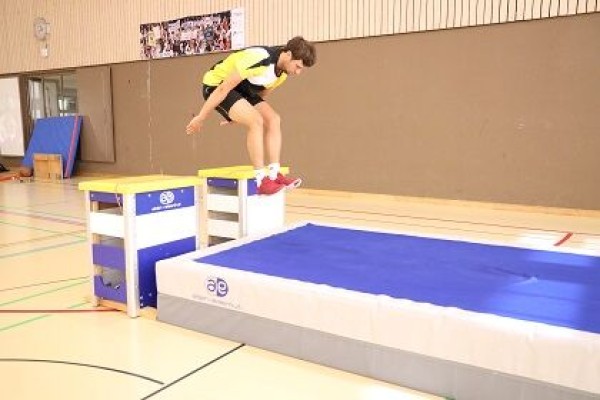
Start with a straight run-up, frontal jump, support yourself with your hands on one of the two vaulting boxes, bring your legs between your arms to stand on the large soft mat.
outdoor:
Straight run-up, frontal jump followed by a squat jump and short support phase with both hands over the obstacle.
Variations:
One-legged or two-legged jump;
Shorter or longer obstacle.
2 vaulting boxes ►indoor version
1 soft mat (large) ►indoor version
1 elasticated rubber band ►indoor version
Indoor post set-up:
Place two vaulting boxes next to each other at a distance of approx. 50 cm. 50cm apart, place a large soft mat behind them and stretch an elastic rubber band between the vaulting boxes if necessary.
outdoor:
A table (approx. size of a table tennis table).
Cat's jump II
Parkour
Individual work
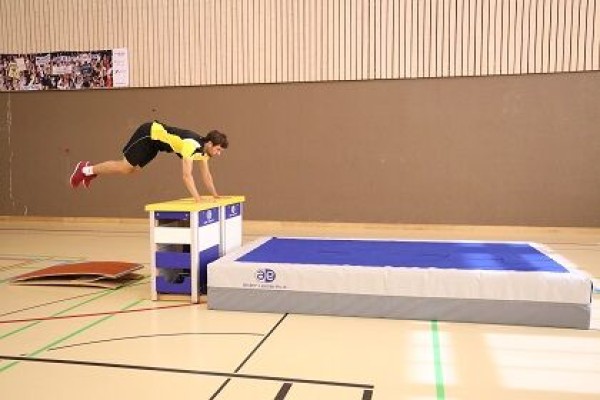
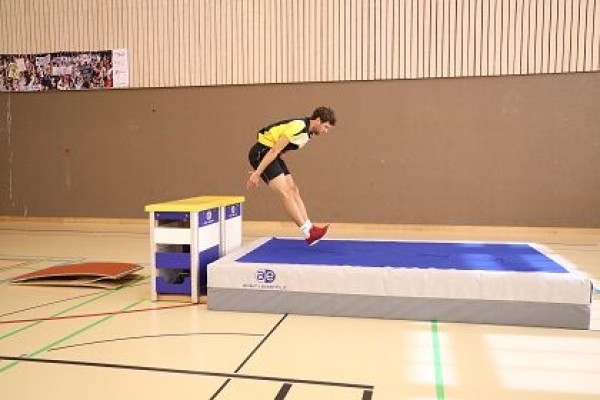
Strong run-up, two-legged take-off from the Reuter board, support yourself with both hands on the vaulting box, pass your legs between your arms to land on the soft mat.
Variant:
Landing with both feet between your hands on the vaulting box, direct take-off to stand on the soft mat.
1 vibratory box
1 soft mat (large)
1 Reuter board
Post setup:
Place the vibratory box between a Reuter board and a large soft mat.
Cat's jump III
Parkour
Individual work
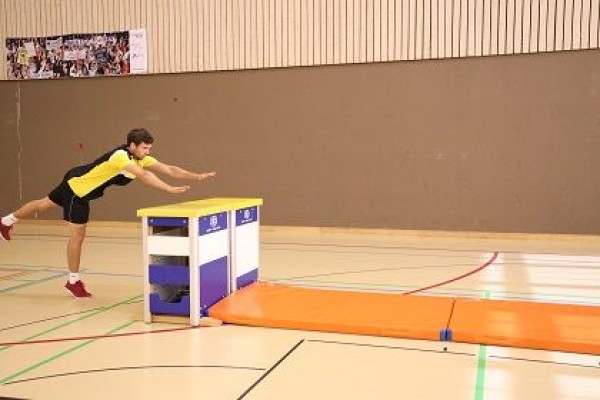

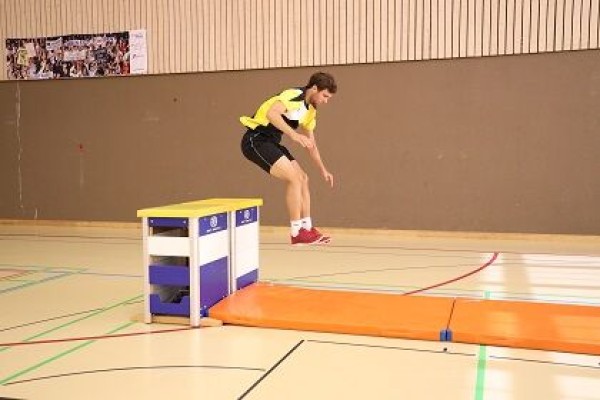
Strong run-up, frontal take-off, moving the centre of gravity forwards, support yourself with both hands on the vaulting box, bring your legs between your arms to land on the small soft mat.
1 vaulting box
1 soft mat (small)
Post setup:
Place a small soft mat behind a vaulting box.
Climbing on horseback
Parkour
Individual work
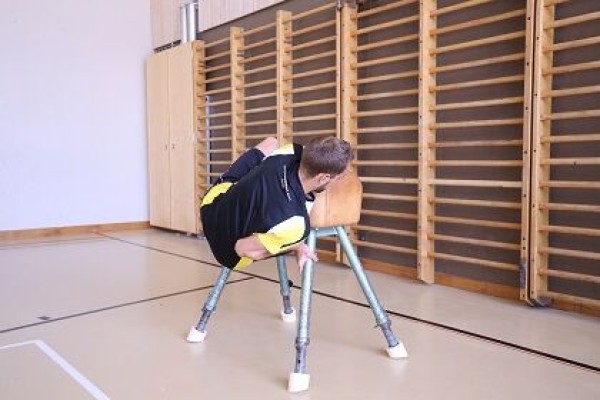
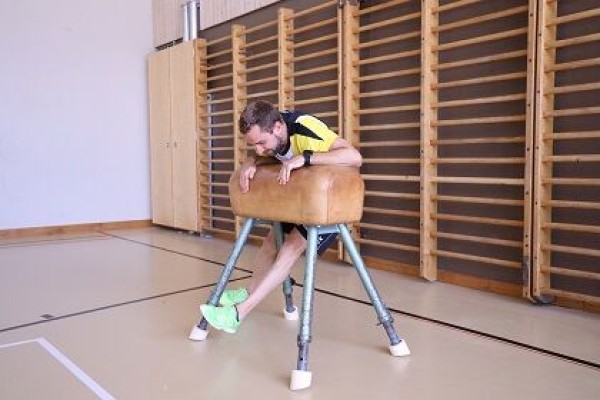
Hold on to the horse with your arms and legs and climb around it without touching the ground.
1 pommel horse
Climbing on rope for a limited time
Climbing
The participants climb up the rope to the marker. A team mate stops the time. Each participant completes at least two attempts.
1 climbing rope
1-2 soft mats (large)
1-4 stopwatches
Climbing on the long bench
Parkour
Individual work

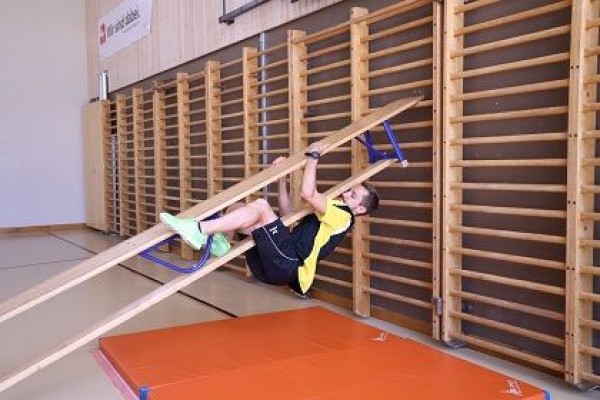
Hold on to the long bench with your arms and legs and climb around it without touching the ground.
1 wall bars
1 long bench
Post setup:
Hook one side of a long bench to the wall bars at a height of approx. 1 metre.
Climbing on the inclined bar
Climbing
Practise the climbing technique on the inclined pole:
Swing back and forth from pole to pole
- Walk up to the mark on two poles
- Walk up to the mark on one pole
- Walk up to the mark on two poles, but feet first
- Running on one pole up to the mark, but feet first
- Swinging on two poles up to the mark
- Swinging on one pole up to the mark
Variant:
Participants learn to perform a full turn backwards and improve their spatial awareness and orientation skills with this exercise: jump up, assume a tumbling hang position and drop backwards onto their feet and a mat (roll backwards).
1 climbing pole
1-2 soft mats (large)
Climbing on the pole for a limited time
Climbing
The participant climbs up the pole to the marker. The sports leader or a team mate stops the time. Each participant completes at least two attempts.
1 climbing pole
2-6 soft mats (small)
1-5 stopwatches
Climbing technique on the rope
Climbing
Practise the climbing technique on the climbing rope:
- Sitting on a swinging box
- Jumping from the ground or swinging box to the rope and holding on for a few seconds
- Climbing up the rope to the mark
- Swinging from rope to rope from one swinging box to another
Variant:
To start, the participant stands on a vaulting box. The participant clamps a ball between their legs, grabs the rope, swings forwards and tries to hit a target with the ball (vaulting box element without a lid or clubs)
1 climbing rope
1-2 soft mats (large)
1-2 vaulting box
Variation of the exercise:
1 soft/foam ball
10 clubs or 1 vaulting box element